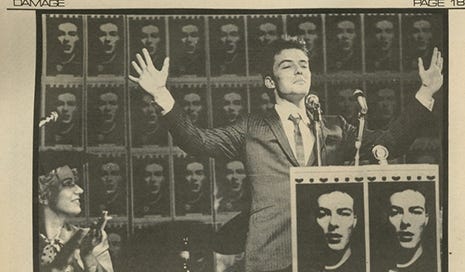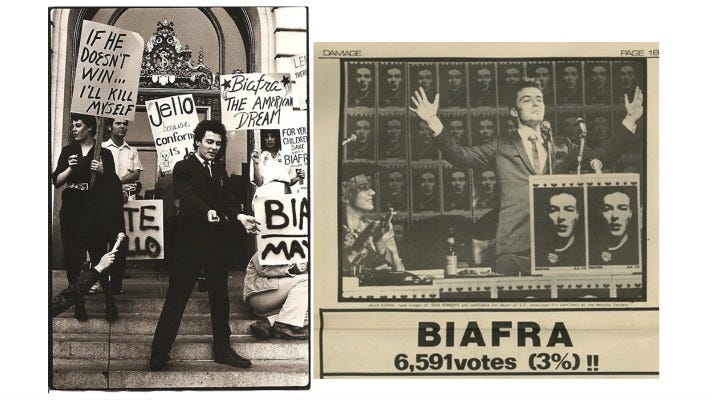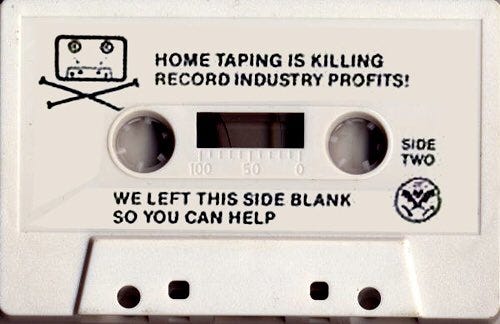West Coast Hardcore Punk & Grunge: Protest Against Police, Religion and Reagan
The underground economy which angered Ronald Reagan and the conflict in hardcore punk.
There's always room for jello – slogan for Jello Biafra's campaign (real name Eric Reed Boucher) (Bickel, 2015)
As previously discussed in Every Single Sound Speaks In The Plural: West Coast hardcore punk and grunge , the hardcore punk movement was a rebellion movement against the political social fabric that it existed in.
Musically, ‘’dissonance in modern art represents the contradictions of [the] contemporary […] by dissolving the standards of musical composition, atonality shows in its form the falsity of our social order’’(Payne and Roberts, 2019,p.476). Theodor Adorno explains that ‘’the dissonant chord, by comparison with consonance is not only the more differentiated and progressive, but furthermore, it sounds as if it had not been completely subdued by the ordering principle of civilization’’(Payne and Roberts, 2019,p.476). This can be applied to punk when considering how often it is characterised as dissonant and lacking in melodic phrases. Rock music too often uses dissonant chords and relies on heavy distortion effects (which provides another dimension of dissonance). Dissonance is, therefore, an important confirmation and celebration of freedom against a social order. Minor Threat’s ‘’Filler’’ (1984) and Dead Kennedys’ ‘’Advice from Christmas Past’’ (1982) use dissonant chords. The vocal tonality clashes with the music. However, hardcore punk extended its protest beyond music techniques. In 1979, Dead Kennedys frontman Jello Biafra ran for San Francisco mayor and finished 4th with 6,591 votes (3.79%), (Bickel, 2015). Jello Biafra (taking his pseudonym from the 1980s cult dessert and the starvation crisis in Biafra, 1967) remarked in ‘’We've Got a Bigger Problem Now’’(1981):
‘’I am Emperor Ronald Regan
Born again with fascist cravings
Still, you make me president
Human rights will soon go 'way
I am now your Shah today
Now I command all of you
Now your gonna pray in school
And I'll make sure they're Christian too’’
(Biafra and Ray, 1981)
In addition to comparing Ronald Reagan to a fascist emperor in the song, in ‘’Moral Majority’’(1983) Biafra criticises the political, Christian right organisation founded by Jerry Falwell in 1979.
In the 1960s and 1970s televangelist figures such as Jerry Falwell, Oral Roberts and Rex Humbard ‘’entered first-run syndication by each purchasing airtime on more than 300 local stations and attracting weekly audiences of between 1 million and 7 million viewers’’(Murray, 2018,p.135). At the same time, religious radio stations tripled to thousand outlets during the 1970s (Murray, 2018,p.135). In the 1970s and 1980s, evangelicals emphasized propositional truth and experiential piety. However, the 1980s financial and sexual scandals ‘’brought down prominent televangelists Oral Roberts, Jim Bakker, and Jimmy Swaggart’’. (Murray, 2018,p.136). Jim Bakker was sentenced to 45 years in prison in 1989 after eight mail frauds, 15 wire frauds and one count of conspiracy.
Bakker had hosted his show The PTL Club, yet misuse of money became to prominence. In 1987 Bakker had used $279,000 of PTL money in order for the church secretary Jessica Hahn to remain silent on her claim that Bakker had sexually assaulted her in a hotel in Florida in 1980. PTL became questioned further of the $4.2 million monthly income and $7.2 million in expenditures (Bertram, 2021). Whilst scandals had surrounded the televangelists, People for the American Way (PFAW) advertised the Media Fairness Project with prominent conservative televangelists such as Jerry Falwell and targeted the:
‘’moral majoritarians: urging their nationwide audiences to view anyone who disagrees with them as a sinner and anyone who won't conform to their narrow orthodoxy as un-American’’(Sinitiere, 2015,p.111).
Jerry Falwell, a televangelist, helped to strengthen the religious right in American politics and associated them with the Republican party. He gained momentum with other conservative Christians by taking on the satanic panic of the 1980s that claimed satanic cults were threatening to expand through godless teenagers and their musical preferences. This led to cases such as the West Memphis Three in 1993, in which ‘’three teenagers whose wrongful conviction on homicide charges was based on little more than suspicion over their goth lifestyles’’ (Romano, 2021). Therefore, the growing underground scene's anti-religious stance was threatful to the preservation of Christianity in American cultural systems.
However, not only was hardcore punk threatful for Christianity. The relationship between police and punk was also tense, as ‘’cops thought punk was a rebellion that threatened them, the American society in general, and they wanted to stomp it out’’ (Blush, 2010, p.41). Pat Dubar from bands Unity and Uniform Choice states that, for the LAPD, the best targets were hardcore kids, as
‘’most of these kids were runaways or from dysfunctional families or had parents that didn’t give a shit. So, it was a safe bet that if they wanted to beat the fuck out someone, they could-95 percent of the time nothing would happen. So, it was a chance worth taking, and they did’’ (Blush, 2010, p.42).
This is the social fabric of hardcore punk and their anti-establishment and anti-police approaches. This social fabric is also found in the practices of exclusivity conducted by the American political system regarding the lower proportions of the American class system (as discussed in previous post).These elements were incorporated into the Pacific Northwest scene of the 1990s. Seattle became a focal point for the middle-lower class social bracket, celebrating the outsider-loser label, whilst subverting stereotypes about the lack of interests and limited intelligence of the lower classes regarding political, environmental, and social issues.
Ronald Reagan claimed that he wanted to lower tax to increase talent within the elites. However, he was also concerned about talent and mobility in the lower ranks of society. Whilst the underground movements rebelled against such ideas, ‘’Regan had expressed anger at an 'underground economy' based around a disturbing trend’ of cash sales and bartering’’ (Mattson, 2020,p.76). The fan zines Subterranean Pop (later known as Sub Pop which would become the iconic grunge label) from Seattle and Talk Talk from Madison, WA produced cassette tape compilations with their zines thus showcasing local performers.
Barry Solztz from the Suburban Relapse zine made it clear that ‘’there’s more in this cassette explosion that meets the eye, many people are and have been creating wild music and releasing it on limited edition tapes […] The cassette market is young’’ (Mattson, 2020,p.75). With such freedom, more artists could spread their music without the control of major labels and other authoritative organisations. Not only did major labels lose potential income but it made the underground scene thrive. All of this meant that underground music once again clashed with conservative ideas and ideologies. Bands such as Bad Religion lyricised their favour of atheism and cassettes were an easy tool to spread such ideas and that posed a threat to politics.
In 1981, Talk Talk claimed that the music industry bore ‘’a great deal of the blame for the near-collapse of the industry which exists today is placed on the 'home-tapers' or those who buy blank tapes and then record from borrowed records or from the radio’’ (Mattson, 2020,p.75).The previous year, Warner Brothers completed a home taping survey to help the Record Industry Association of America to get out of what Kevin Mattson describes as one of the worst years for the record industry (1981 btw). Mattson explains that Reagan feared such an economy did not generate tax revenue and that the economic problems faced by the major entertainment corporations (which helped to guide the president's career) in 1981 needed to be addressed.
The fan zine- Ripper asked ‘’why should you want to pay taxes now that the government has cut back on the programs that were helping people so they can spend more on the military to kill people?’’(Mattson, 2020,p.76). Attitudes such as this helped to fuel 1980s punk against capitalism and turned American underground scenes onto left-wing ideologies. In 1982, Olympia, Washington's KRecords advertisements highlighted that the ‘’cassette revolution is exploding the teenage underground into passionate revolt against the corporate ogre’’(Mattson, 2020,p.75). The cassette tapes were an important element in American underground music and its progression but were also an important element of protest.
Dead Kennedys cassette for ‘’In God We Trust’’ ,1981. (Mills, 2019)
Famously, Dead Kennedys became one of the bands to take on the fight against the record industry with their cassettes for ‘’In God We Trust’’(1981). They had one of their sides left blank featuring a pirate logo (mimicking the slogan of the Record Industry Association of America) and the words ‘’home taping is killing record industry profits! We left this side blank so you can help out!’’(Mattson, 2020,pp.74-75). As mentioned before, such cassette tapes advertised the hardcore punk mentality. They became threatening to politicians as the underground movement had gained momentum to the point of becoming mainstream with grunge in 1990s. As discussed throughout the previous blog entries, hardcore punk`s mentality and approach are imortant for grunge musicians and designer Art Chantry. Their ability to reach a wide audience showcases the power and importance they held in the underground movement and in wider society.
Conflict in Hardcore punk.
George Hurchalla notes that rather than ‘’welcome the growth of all these new bands, localism about who had the best hometown scene became an issue among punk’’ (Hurchalla, 2016, p. 109). Ian MacKaye, who was a driving force and authority figure within the hardcore underground scene with his political bands Fugazi and Minor Threat, concluded after the first San Francisco show (1981) that the scene turned:
‘’in the fighting sense who is tougher than who. That's what I felt was going on when I was tackled at a show. But apparently, it’s some kind of local tradition here, to tackle out of town bands’’ (Hurchalla, 2016, p. 110).
The New Jersey band the Misfits, with frontman Glen Danzing, were famous for getting into conflicts with other bands, threatening to ‘’beat the crap out of’’ Jello Biafra due to him ‘’stealing Halloween’’ (using the same song name) from them (Nardwuar the Human Serviette, 2021). Hurchalla notes that ‘’DC and Boston bands brough hostility to New York and LA, as they were resentful of the great attention that those cities always got, for everything that happened’’ (Hurchalla, 2016, p. 116). The conflicts extended further between punk and hardcore scenes. For example, ‘’the consciousness that developed means that to this day relatively few Chicago punks agree with each other's views on the scene’’ (Hurchalla, 2016, p. 143). As ‘’large personality conflict between two of the most vocal people in the scene, John Kezdy and Articles of Faith frontman Vic Bonid, got far too much play in the undergoing media at the expense of everything else that was going on the scene, (Hurchalla, 2016, p. 143).
The growing rivalry in hardcore punk was not followed by those in the grunge community. The media in the 1990s aimed to write a sensationalised narrative about a rivalry between Kurt Cobain and Eddie Vedder. Both, however, were quick to deny it. Band rivalry in grunge never became as prominent as in the Chicago punk scene. Rivalry in the Chicago punk scene overshadowed political messages and clarifies that power and influence were important for hardcore punk. Black Flag’s Henry Rollins, for example, became a glamourised figure across fan zines and went on to become an underground celebrity.
But figures in the hardcore punk scene greatly influenced Seattle musically and ideologically by embodying protests against Republicans. Important musicians such as Henry Rollins and Gregg Gin (also from Black Flag), Jello Biafra (Dead Kennedys) and Ian MacKaye (Minor Threat, Fugazi) played a critical role in the formation of the Seattle grunge scene. Notably, Black Flag was the first band Kurt Cobain saw play live (Nardwuar the Human Serviette, 2021). Pat Smear from the punk bands The Germs, Meat Puppets and Adolescent, who played with Nirvana in 1993, worked at SST Records on Sunset Boulevard (peskymeddlinggirls,2020). Seattle artists consistently showed support for hardcore bands with Eddie Vedder, for example, wearing a Minor Threat shirt. Photographer Pat Blashill asks:
‘’So, what does it mean today to see Pearl Jam's Eddie Vedder wearing a Minor Threat punk-rock T-shirt? It means that he is acting out one of the most inexorable impulses of indie rock-that is, the fiendish desire to turn anyone who will listen on to something new: a band they might not have heard, a magazine they didn’t know about, a snowboard shop they've never seen. It means that Eddie is a fan, not just someone who inspires fans. The rock T-shirt is the sartorial shorthand of our generation. It says, ‘’I like this music-I am this culture’’. No other explanation from the wearer is necessary’’ (Blashill, 1996, p. 21).
For punk and grunge, aesthetic presentation is an important element of protest. Eddie Vedder wearing a Minor Threat shirt indicates grunge artists’ desire to be associated with punk and agreeing with its values as well as allowing Vedder to personally demonstrate his taste and cultural capital. This can also be seen in Art Chantry`s designs and you can find out how and why if you click this or that, or even this!!!!!!!!!!







